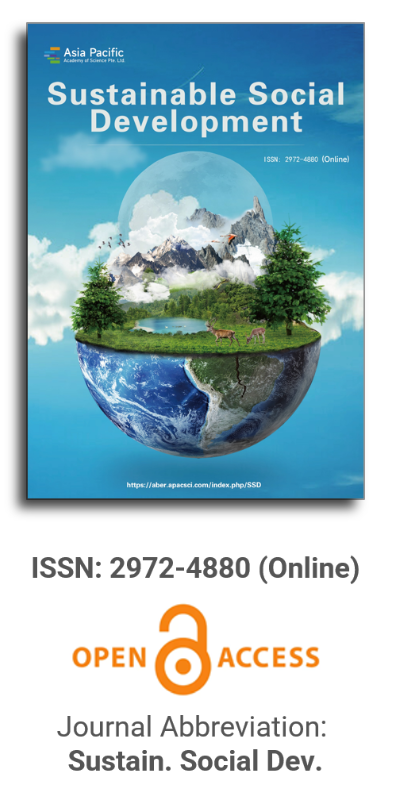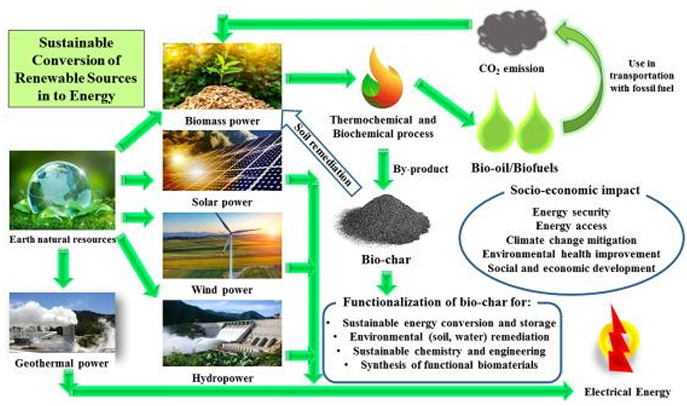
Asia Pacific Academy of Science Pte. Ltd. (APACSCI) specializes in international journal publishing. APACSCI adopts the open access publishing model and provides an important communication bridge for academic groups whose interest fields include engineering, technology, medicine, computer, mathematics, agriculture and forestry, and environment.

Enabling gender responsive low-carbon transport in India using SDG5 framework
Vol 2, Issue 5, 2024
Download PDF
Abstract
Gender and mobility are strongly related and address challenges of safety and accessibility for women. Studies worldwide highlight the need to create more gender-responsive transport systems that maximize women’s mobility, civic participation, and safety. Gender inequality in urban transport is evident in Indian cities in terms of women’s longer walking trip lengths, longer time spent in commute and hence time poverty, impoverished health, and compromised personal safety. Even the public transport systems, often perceived as more gender-equal, overlook women’s needs and mobility concerns such as affordability and scheduling. This article presents transportation challenges faced by women (recorded through primary surveys and focus-group discussions) and further investigates how low-carbon urban transport, as perceived under the Paris Agreement and Sustainable Development Goals (SDGs), can be delivered with gender-equitable outcomes. For a more holistic perspective, the assessment is grounded in two Indian cities, Surat (4.5 million population), a fast-growing industrial metropolis, and Udaipur (0.5 million population), a small but important tourist destination in the nation.
Keywords
References
- In focus: Sustainable Development Goal 5. Available online: https://www.unwomen.org/en/news-stories/in-focus/2022/08/in-focus-sustainable-development-goal-5 (accessed on 2 June 2024).
- Explainer: Sustainable Development Goal 5. Available online: https://www.unwomen.org/en/news-stories/explainer/2022/09/explainer-sustainable-development-goal-five (accessed on 2 June 2024).
- UN Women. Progress on the Sustainable Development Goals: The gender snapshot 2022. Available online: https://www.unwomen.org/en/digital-library/publications/2022/09/progress-on-the-sustainable-development-goals-the-gender-snapshot-2022 (accessed on 2 June 2024).
- Mahadevia D. Gender Sensitive Transport Planning for Cities in India in Promoting Low Carbon Transport in India. United Nations Environment Programme (UNEP); 2015.
- GIZ & SUTP. Approaches for Gender Responsive Urban Mobility. Available online: https://sutp.org/publications/approaches-for-gender-responsive-urban-mobility-gender-and-urban-transport-smart-and-affordable/ (accessed on 2 June 2024).
- World Bank. Sustainable Mobility for All. Global Roadmap of Action Toward Sustainable Mobility: Gender. World Bank; 2019.
- International Labor Organization. The World Employment and Social Outlook: Trends for Women 2017. International Labor Office; 2017.
- Machado AL, Alves B, Portabales I, et al. Why Does She Move? A Study of Women’s Mobility in Latin American Cities. World Bank; 2020.
- Alam MM. Creating Pro-Poor Transport. Available online: https://doi.org/http://documents.worldbank.org/curated/en/2016/01/25793499/creating-pro-poor-transport-connecting-dots-transport-growth-poverty-reduction (accessed on 2 June 2024).
- Chant S. Cities through a “gender lens”: a golden “urban age” for women in the global South? Environment and Urbanization. 2013; 25(1): 9-29. doi: 10.1177/0956247813477809
- Peters D. Gender and Sustainable Urban Mobility. Official Thematic Study for the 2013 UN Habitat Global Report on Human Settlements. 2013. doi: 10.13140/RG.2.1.4746.9287
- MOHUA. Service level Benchmarking for Urban Transport in Indian Cities. Available online: https://mohua.gov.in/upload/uploadfiles/files/VoulmeI_Methodologyreport_final03.pdf (accessed on 2 June 2024).
- Mahadevia D, Mukhopadhyay C, Lathia S, Gounder K. The role of urban transport in delivering Sustainable Development Goal 11: Learning from two Indian cities. Heliyon. 2023; 9(9): e19453. doi: 10.1016/j.heliyon.2023.e19453.
- Surat Municipal Corporation. Comprehensive Mobility Plan for Surat 2046. CEPT University; 2016.
- Udaipur Municipal Corporation. Low-Carbon Mobility Plan for Udaipur 2040. UNEP; 2013.
- Allen H. Approaches for Gender Responsive Urban Mobility. Available online: https://womenmobilize.org/wp-content/uploads/2020/02/A_Sourcebook_Social-Issues-in-TransportGIZ_SUTP_SB7a_Gender_Responsive_Urban_Mobility_Nov18-min.pdf (accessed on 2 June 2024).
- Mahadevia D, Advani D. Gender differentials in travel pattern—The case of a mid-sized city, Rajkot, India. Transportation Research Part D: Transport and Environment. 2016; 44: 292-302. doi: 10.1016/j.trd.2016.01.002
- Shah S, Viswanath K, Vyas S, Gadepalli S. Women and Transport in Indian Cities, ITDP and Safetipin, New Delhi. Available online: https://www.itdp.in/wp-content/uploads/2017/12/171215_Women-and-Transport-in-Indian-Cities_Final.pdf (accessed on 2 June 2024).
- Mahadevia D, Lathia S. Women’s Safety and Public Spaces: Lessons from the Sabarmati Riverfront, India. Urban Planning. 2019; 4(2): 154-168. doi: 10.17645/up.v4i2.2049
- Desai R, Parmar V, Mahadevia D. Resettlement, Mobility and Women’s Safety in Cities. India’s Contemporary Urban Conundrum. Published online November 15, 2018: 65-76. doi: 10.4324/9780429023996-6
- Phadke S. ‘You Can Be Lonely in a Crowd.’ Indian Journal of Gender Studies. 2005; 12(1): 41-62. doi: 10.1177/097152150401200102
- Anand A, Tiwari G. A Gendered Perspective of the Shelter–Transport–Livelihood Link: The Case of Poor Women in Delhi. Transport Reviews. 2006; 26(1): 63-80. doi: 10.1080/01441640500175615
- Arora A, Tiwari G. A handbook for socio-economic impact assessment (SEIA) of future urban transport (FUT) projects. TRIPP, Indian Institute of Technology Delhi; 2007.
- Tiwari G, Nishant. Travel to Work in India: Current Patterns and Future Concerns. Transport Research & Injury Prevention Programme, Indian Institute of Technology Delhi. Indian Institute of Technology Delhi; 2018.
- Ng WS, Acker A. Understanding Urban Travel Behaviour by Gender for Efficient and Equitable Transport Policies. Available online: https://www.itf-oecd.org/understanding-urban-travel-behaviour-gender-efficient-and-equitable-transport-policies (accessed on 2 June 2024).
- Sánchez de Madariaga I. The Mobility of Care: A new Concept in Urban Transportation. In: Sánchez de Madariaga I, Roberts M (editors). Fair Share Cities: The Impact of Gender Planning in Europe. Ashgate; 2013.
- Verma M, Manoj M, Rodeja N, et al. Service Gap Analysis of Public Buses in Bangalore with Respect to Women Safety. Transportation Research Procedia. 2017; 25: 4322–4329.
- Bhatt A, Menon R, Khan A. Women’s Safety in Public Transport: A Pilot Initiative in Bhopal. The WRI Ross Center for Sustainable Cities; 2015.
- Kumar Y. From Capacity to Capability: Bringing More Women in Logistics and Transport. Available online: https://www.news18.com/news/opinion/from-capacity-to-capability-bringing-more-women-in-logistics-and-transport-4844723.html (accessed on 2 June 2024).
- Alam MM, Dappe MH. Shaping women’s access to opportunities: Gender, transport, and employment in Mumbai. End Poverty in South Asia. 2021. Available online: https://blogs.worldbank.org/endpovertyinsouthasia/shaping-womens-access-opportunities-gender-transport-and-employment-mumbai (accessed on 2 June 2024).
- Turnbull P. Promoting the Employment of Women in the Transport Sector—Obstacles and Policy Options. Working Paper No. 298, Sectoral Activities Department, International Labour Office, International Labour Organization, Geneva; 2013.
- Peake LJ. Gender and the City. International Encyclopedia of Human Geography. 2020; 281-292. doi: 10.1016/b978-0-08-102295-5.10186-6.
- Turner J, Fouracre P. Women and transport in developing countries. Transport Reviews. 1995; 15: 77-96.
- Avery L, Regmi M, Joshi G, et al. Rural-Urban Connectivity in Achieving Sustainable Regional Development. Available online: https://www.uncrd.or.jp/content/documents/5048Final%20Background%20Paper%20for%20EST%20Plenary%20Session%203%20(1)-rev-3.pdf (accessed on 2 June 2024).
- Ishwari P. NFHS Data Shows 60% Women Face Trouble Accessing Healthcare. Available online: https://www.newsclick.in/NFHS-data-shows-6o-per-women-face-trouble-accessing-healthcare (accessed on 2 June 2024).
- Khullar A. Gender-Responsive Budgeting in India: A Stocktaking. Available online: https://www.orfonline.org/research/gender-responsive-budgeting-in-india-a-stocktaking (accessed on 2 June 2024).
- Information Department, Government of Gujarat. Chief Minister’s people-centric approach to promote an environmentally responsible urban transport service in the state. Available online: https://cmogujarat.gov.in/en/important-decisions/environmentally-responsible-urban-transport-service#:~:text=12.50.,1%2C068%20CNG%20buses%20are%20operational (accessed on 2 June 2024).
- Institute for Transportation & Development Policy (ITDP). Available online: https://itdp.org/wp-content/uploads/2019/01/ST_30_FINAL_.pdf (accessed on 2 June 2024).
- Ohlund H, El-Samra S, Adriazola-Steil C, et al. Invest in Walking and Cycling for Sustainable, Safe Cities. Here’s How. WRI; 2021.
- Mahapatro D. Gender and Mobility. Statement to the SMART-SUT Mobilogues Series—GIZ; 2021.
- World Bank Group. Making Way for Women in Transport and Logistics: Promising Practices in Europe and Central Asia. Available online: https://www.worldbank.org/en/news/feature/2023/01/26/making-way-for-women-in-transport-and-logistics-promising-practices-in-europe-and-central-asia (accessed on 2 June 2024).
- Asian Development Bank. India: Delhi–Meerut Regional Rapid Transit System Investment Project—Gender and Social Inclusion Action Plan. Available online: https://www.adb.org/sites/default/files/project-documents/51073/51073-004-fam-en.pdf (accessed on 2 June 2024).
- Gonzalez K, Kumar S, Mehndiratta S. When Good Transport Alone Doesn’t Bring Jobs Closer to Women: Insights from Mexico. Available online: http://blogs.worldbank.org/transport/when-good- transport-alone-doesn-t-bring-jobs-cservice leveler-womeninsights-mexico-city (accessed on 2 June 2024).
- Ministry of Housing & Urban Affairs (MoHUA), Government of India and ITDP, India. India Cycle for Change Challenge—The Dawn of a Cycling Revolution. Available online: https://itdp.in/wp-content/uploads/2022/07/A-Dawn-of-a-Cycling-Revolution-Publication.pdf (accessed on 2 June 2024).
Supporting Agencies
Copyright (c) 2024 Darshini Mahadevia, Saumya Lathia, Kanika Gounder
License URL: https://creativecommons.org/licenses/by/4.0/

This site is licensed under a Creative Commons Attribution 4.0 International License (CC BY 4.0).

Prof. Kittisak Jermsittiparsert
University of City Island, Cyprus





It is with deep regret that we announce the cancellation of the Forum on Sustainable Social Development & Computing and Artificial Intelligence, originally scheduled for June 15, 2025.

